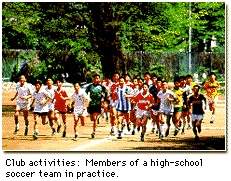 |
 Japanese
children enter the first grade of elementary school in the April
after their sixth birthday. They attend elementary school for six years,
where they study Japanese, arithmetic, science, social studies, music,
crafts, physical education, and home economics (to learn simple cooking
and sewing skills). During their three years in middle school, English
is added to this list. Recently, the number of schools using computers
has increased, and many have access to the Internet. Japanese
children enter the first grade of elementary school in the April
after their sixth birthday. They attend elementary school for six years,
where they study Japanese, arithmetic, science, social studies, music,
crafts, physical education, and home economics (to learn simple cooking
and sewing skills). During their three years in middle school, English
is added to this list. Recently, the number of schools using computers
has increased, and many have access to the Internet.
There are around 30 students in a typical elementary school class. In most elementary and some middle schools, the children eat lunch together in the classroom, enjoying a healthy, nutritious meal prepared by the school or by a local "school lunch center." Every day the students also clean the rooms, halls, toilets, and yards of their own school. Most middle schools require uniforms for their students. Almost all middle school students take part in an after-school club activity of their choice, such as a musical or arts group, a sports team, or a science club.
Students must pass tests in order to enter high school or college, and they study very diligently for these exams. It is not unusual for high school graduates who fail on their first sitting to attend a special school for a year or two to prepare for a second or third try at the college entrance exams. Some people worry that studying so hard for the exams throws the youngsters' mental, moral, and physical development off balance.
Photos courtesy of Tokyo Metropolitan Government.

|
 There are many school events
during the year, such as field day when students compete in tug-of-war
and relay races,
There are many school events
during the year, such as field day when students compete in tug-of-war
and relay races,  All Japanese children are required to attend school through the ninth grade. Although schooling is not compulsory after middle school, nearly 97% of Japanese students go on to high school, which lasts for three years. Over 48% of high school graduates go on to four-year universities or two- or three-year junior colleges.
All Japanese children are required to attend school through the ninth grade. Although schooling is not compulsory after middle school, nearly 97% of Japanese students go on to high school, which lasts for three years. Over 48% of high school graduates go on to four-year universities or two- or three-year junior colleges.
